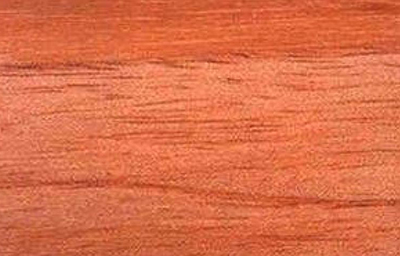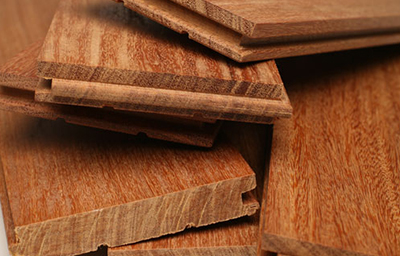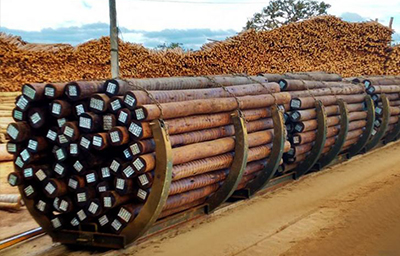Tropical timber refers to any type of timber or wood that grows in tropical rainforests in which there is no dry season. Tropical forests in Central and South America and Africa are often harvested by a practice called Selective Logging which if done correctly, minimally damages the rainforest and the forest grows back quickly.
Wood from tropical trees is used in a variety of ways. Furniture is the most obvious, but hardwood flooring, boat fixtures, ornamental wood pieces, and other wood products all may use tropical tree species. There are hundreds of tropical hardwood types that are used in woodworking.
Here are some of the most common tropical species we offer at Kamsource:

Angelim Pedra
The colour of fresh sawn heartwood is orange yellow brown, darkening to (dark) brown and the sapwood is clearly demarcated. The wood has a remarkable stripy pattern. The large trees reach up to about 45 m, with diameters up to 120 cm.
The grain is straight to irregular and sometimes interlocked. The texture is coarse. The timber has fresh sawn a typical smell which disappears with time. Machining goes well, specially with hard metal tools. Pre-drilling is recommended.


Cedro
Heartwood is a relatively uniform light pinkish to reddish brown; colors tend to darken with age. Grain patterning and figure tends to be straight or shallowly interlocked and somewhat bland. Medium texture and moderate natural luster.
Spanish Cedar is easy to work with both hand and machine tools. However, it tends to leave fuzzy surfaces if not machined with sharp cutters; extra sanding up to finer grits may be required to obtain a smooth wood surface. It is used as veneer for back or face of plywood, Interior joinery, and Cigar boxes.


Cumaru
Heartwood tends to be a medium to dark brown, sometimes with a reddish or purplish hue; some pieces may have streaks of yellowish or greenish brown. Grain is interlocked, with a medium texture and a waxy feel. The heartwood fluoresces under a blacklight, which can help distinguish it from Ipe.
Cumaru is resistant to rot and decay, and has excellent durability and weathering properties making it a perfect choice for exterior applications such as decking. It not only lasts a long time, but has the beauty of an interior hardwood.


Cupiuba
The wood is yellow reddish brown, sometimes with presence of internal stresses. It has clearly demarcated sapwood. Cupiuba has an unpleasant odour which may limit the use of this timber. The grain is interlocked and the texture is medium.
Cupiuba is found in the Amazon region and can reach up to 35 feet. It blooms over a long period of the year, especially in October and November. It can be used for industrial or heavy flooring, sliced veneer and joinery


Eucalyptus
Eucalyptus also grows in South America, where it was imported to Brazil in the early 1900s. The heartwood is red to reddish-brown, and darkens as it seasons. Its sapwood is pale cream. The grain of this tree is slightly interlocked, with sometimes ripply or fiddleback patterns. It has a medium to coarse texture.
Eucalypts are evergreen hardwoods, shedding leaves continuously throughout the year. They are moderately resistant to termites, but susceptible to marine borers and pinhole borers. Eucalyptus is used for all types of construction, fine as well as utilitarian, light and heavy and it is often made into flooring.


Goncalo Alves
Goncalo Alves is commonly referred to as “Tigerwood” or “Brazilian Tigerwood” among flooring dealers. It’s Heartwood is typically a medium reddish brown with irregularly spaced streaks of dark brown to black. Color tends to darken with age.Grain can be straight, but is usually wavy or interlocked.
Goncalo Alves is generally not too difficult to work, despite its high density. The wood has superb stiffness, strength, hardness, and durability. It has fine, uniform texture with good natural luster.


Ipe
Ipe is a wood of extremes: extremely dense and durable, as well as extremely difficult to work. Heartwood can vary in color from reddish brown, to a more yellowish olive brown or darker blackish brown. It has a fine to medium texture, with the grain varying from straight to irregular or interlocked. Moderate natural luster.
Its incredible hardness and strength make it well suited for flooring applications, though it is referred to as “Brazilian Walnut”, it is not related to true Walnut. Ipe's naturally durable and weather resistant characteristics is why it is primarily sold as decking or flooring. Boards for furniture or general use are sometimes available as well.


Jatoba
Heartwood varies from a light orangish brown to a darker reddish brown, sometimes with contrasting darker grayish brown streaks. Color tends darken upon exposure to light. Sapwood is a light grayish yellow, clearly demarcated from the heartwood.
Jatoba is exceptionally stiff, hard, very heavy, and very tough. The grain is commonly interlocked with a medium coarse texture and good natural luster. It is somewhat difficult to work due to its hardness and weight, however Jatoba remains a popular choice for furniture pieces and other woodwork.


Massaranduba
Heartwood is a medium to dark reddish brown with purplish shades and tends to darken with age. Pale yellow sapwood is clearly differentiated from the heartwood, though not always sharply demarcated. The grain is straight and the texture is fine.
Massaranduba is an incredibly strong, dense wood and very durable to fungi. It is durable to dry wood borers and has good durability in exterior applications. Massaranduba can be used for sculptures, tool handles, industrial or heavy flooring, sliced veneer, stairs, furniture


Mahogany
Mahogany has been harvested since the Spanish and English arrived in the New World and quickly seized upon its excellent shipbuilding qualities. Heartwood color can vary a fair amount with Mahogany, from a pale pinkish brown, to a darker reddish brown. Color tends to darken with age. Mahogany also exhibits an optical phenomenon known as chatoyancy.
Grain can be straight, interlocked, irregular or wavy. Texture is medium and uniform, with moderate natural luster. Mahogany’s easy workability, combined with its beauty and phenomenal stability have made this lumber an enduring favorite..


Roxinho
Roxinho is found throughout Brazil, except in the Southern region. It is billiard table PURPLE before being exposed to the sun and weather. It quickly turns a reddish brown in less than 10 days after installation.
The grain is straight and pronounced and there is a gentle color variation from board to board. The texture is medium to fine and It's luster moderate to high. Roxinho costs considerably less than ipe with a more consistent color from board to board, so it is a very popular decking lumber. Other uses include construction, ship's building and fine furniture.


Teak
With its superb stability, good strength properties, easy workability—and most of all, its outstanding resistance to decay and rot—it’s no wonder that Teak ranks among the most desired lumbers in the world.
Heartwood tends to be a golden or medium brown, with color darkening with age. Grain is straight, though it can occasionally be wavy or interlocked. Coarse, uneven texture and moderate to low natural luster. Easily worked with both hand and machine tools and dresses to a very smooth finish. Teak contains a high level of silica which has a blunting effect on cutting edges.


Pau Ferro
Pau Ferro is a wood of many names, and is sometimes called Morado: and because the wood is so similar in appearance and working properties to rosewood, it is also referred to as Santos Rosewood. It is about as close to a true rosewood as a wood can get without actually being a Dalbergia species.
The color can be highly varied, ranging from reddish/orange to a dark violet/brown, usually with contrasting darker black streaks. Narrow sapwood is a pale yellow and is clearly demarcated from the heartwood. Grain is typically straight, though sometimes slightly irregular or interlocked depending on the species. Fine, even texture and a naturally high luster.
